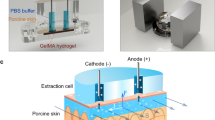Abstract
Purpose. To demonstrate that “reverse iontophoresis” can be used to noninvasively obtain information about systemic glucose levels in vivo in humans.
Methods. The passage of current across the skin in vivo drives ions into the tissue, from the electrode chambers positioned on the skin surface, and simultaneously pulls ions from the body in the opposite direction. Because of the net negative charge on the skin, under normal conditions, the membrane is permselective to cations, and a potential gradient also results, therefore, in electroosmotic convection of solvent in the direction of counterion flow (i.e., from anode to cathode). Thus, it is also possible to enhance the transport of polar, yet uncharged, species using iontophoresis. In an earlier study, the in vitro extraction of glucose, by “reverse iontophoresis” was established, and extension of the approach to an in vivo model was indicated. The idea has therefore been further explored in vivo in humans.
Results. Using small, simple, prototypical electrode chambers, attached to the ventral forearm surface, direct current iontophoresis at 0.25 mA/cm2 for periods of up to 1 hour, and a sensitive analytical procedure to measure the quantities of glucose extracted, it has been shown that iontophoretic sampling of glucose is feasible. However, the shorter periods (15 minutes or less) of extraction considered yield results which are “contaminated” (it is believed) by glucose that is a product of lipid metabolism within the skin. While this material is expected to complicate the initial calibration of the approach, the problem is effectively resolved within one hour, by which time the glucose arriving in the electrode chambers on the skin surface is expected to directly reflect the subcutaneous tissue concentration.
Conclusions. Based upon these initial observations, further investigation can now be directed towards optimization of electroosmotic flow and sampling time, improved reproducibility and the development of a practical assay methodology.
Similar content being viewed by others
REFERENCES
The Diabetes Control and Complications Trial Research Group. N. Engl. J. Med. 329:977–986, 1993.
P. Glikfeld, C. Cullander, R.S. Hinz, and R.H. Guy. U.S. Patent # 5,279,543, “Device for Iontophoretic Non-Invasive Sampling or Delivery of Substances,” (1994).
R.H. Guy, G. Rao, P. Glikfeld, C. Cullander and R.S. Hinz. U.S. Patent # 5,362,307, “Method for the Iontophoretic Non-Invasive Determination of the In Vivo Concentration Level of and Inorganic or Organic Substance,” (1994).
R.R. Burnette. Iontophoresis. In “Transdermal Drug Delivery: Developmental Issues and Research Initiatives”. J. Hadgraft, R.H. Guy, eds. Marcel Dekker, New York, pp. 247–291, 1989.
M.J. Pikal. The role of electroosmotic flow in transdermal iontophoresis. Adv. Drug Del. Rev. 9:201–237, 1992.
G. Rao, P. Glikfeld, R.H. Guy. Reverse iontophoresis: Development of a noninvasive approach for glucose monitoring. Pharm. Res. 10: 1751–1755, 1993.
P. Green, R. S. Hinz, C. Cullander, G. Yamane and R. H. Guy. Iontophoretic delivery of amino acids and amino acid derivatives across the skin in vitro. Pharm. Res. 8: 1113–1120, 1991.
W.R. LaCourse. Pulsed electrochemical detection in high performance liquid chromatography. Analysis 21: 181–195, 1993.
J.C. Miller and J.N. Miller. Statistics for Analytical Chemistry. John Wiley & Sons, New York, 1986, pp. 100–102.
P.W. Ledger. Skin biological issues in electrically enhanced transdermal delivery. Adv. Drug Delivery Rev. 9, 289–307, 1992.
N.Y. Schurer, P.M. Elias. The biochemistry and function of stratum corneum lipids. Adv. Lipid Res. 24: 27–56, 1991.
J.C. Crank. The Mathematics of Diffusion (2nd Edition). Oxford University Press, Oxford, 1976.
Rights and permissions
About this article
Cite this article
Rao, G., Guy, R.H., Glikfeld, P. et al. Reverse Iontophoresis: Noninvasive Glucose Monitoring in Vivo in Humans. Pharm Res 12, 1869–1873 (1995). https://doi.org/10.1023/A:1016271301814
Issue Date:
DOI: https://doi.org/10.1023/A:1016271301814




